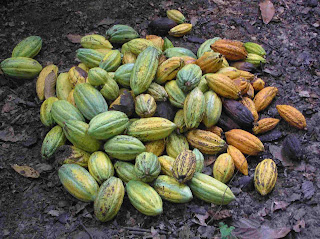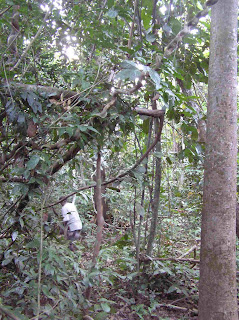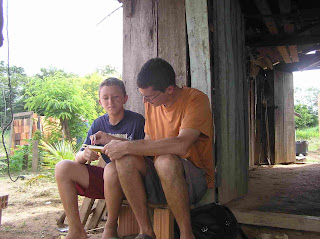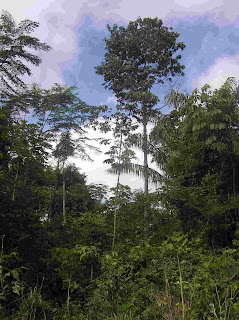Now: Damn I'm good! This slightly egotistical characterization is in reference to the sentiment I recurrently felt on Saturday night. Again, here's the context....
So I wanted to do something special for the three families I have been staying with. Originally I thought I would cook a meal for each of them separately. However, as Saturday, my last day in the settlement rolled around, I realized there was no way I was going to pull off cooking three individual "American" meals...
So I improvised, I thought I'd cook one meal for all the families..and then I thought, wait, I can't cook for the families without inviting all the kids from the youth group I've been with. Sooo...as the rapidly growing guest list (now at around 40) started to cause a panic attack (it was already 2 pm for a 7 pm dinner party), I went into overdrive going to the village's very very sparse "comerciales" (grocery stores that basically sell the very basic staples, rice, beans, pasta, oil, and a few vegetables) to try to find ingredients that I could use to cook an "American" meal for 40 people....what I settled on: a fritatta.
So those who know my cooking skills would doubly echo the title of this blog if they say the preparations, and result:
Ingredients: 60 eggs, a bag of onions, bag of peppers, bag of potatoes, kilo of cheese, and huge bag of steak....
Tools: One dull knife that was probably never meant for cutting, several old pots and large cake pans, an oven that just had an "on" switch, much less a temperature gauge, and a rural clay stove that was built out of mud before the settlement had gotten "development", but are still used frequently....
Workers: Two of the mothers of the houses that I stayed with, their daughters, and a silly gringo
The Process: An amazing and absolutely delightful intercultural learning experience! I "billed it" as an integration of Brazillian and American culture: I taught the mothers how to make a fritatta, and they taught me how to cook beef for 40 people! Considering I've never cooked meat before (much less handled it raw) it was definitely a growth opportunity....



Result: An amazing frittata, cooked perfectly i might add (sorry no photos), forty+ well fed people (perhaps the biggest miracle in itself), and all timelessly integrated into the Youth group's own plan for a going away party for Me!
For while I was running around like an absolute nut, going to people's houses to invite them, getting provisions, like said big bag o meat...., etc, the youth group was planning my going away party. All of this, my dinner party for them, and their going away party was fairly spontaneous and just happened to coincide at the Casa de Cultura (their youth space)...well "just happened" sort of...let's just say I had a vision (damn i'm good)....
So at 8 we started carrying the food into the youth group space. They had the place all set up with a LCD data projector and screen, etc. And then they told me i had to leave, so someone escorted me out, and took me on a somewhat arbitrary and random motorcycle ride around the settlement while the group prepared their event. When we returned, someone stepped outside to indicate that I could come in:
It was very much like the event they had planned to welcome me (although I wasn't blindfolded). Everyone (all 40 or so of them) were crammed into the room, sitting on these red cloths, that are a sort of cultural symbol for the MST. They had me sit on my own cloth in the center of the circle of everyone. And then they began their "mistica", they showed this powerpoint which was a combination of some poetry with John Lennon's imagine in the background. Each person read a bit of the poetry...and then many gave a little "speech" or reflection on my time there...it was VERY VERY touching. And then they gave me a bag of very thoughtful gifts....books of poetry and other literature that they had written inscriptions in and tucked little hand written notes in....I got a chance to give my own reflections...the whole experience was so special and hard to put words to. The photos below probably mean and say more to me than they do to you, but they are meant to just give you an idea of what I'm describing.
The first is a photo of Dona Olinda reflecting on my time in her house...and reminding me that the doors are always open for me there...

The second is a somewhat funny photo of Luis (the settlement's leader whose wearing a green shirt) giving his 5 minute reflection (very latin american political leader style....)

The next of me opening one of my presents: a via camponesa flag (an international social movement) ((I also got an MST flag that I'm very proud of and will go very well in our house...it's red!)

And a picture of us sitting....

As a relative of mine would have said: wonderful people, a wonderful place, and wonderful memories. Just wonderful...
























































